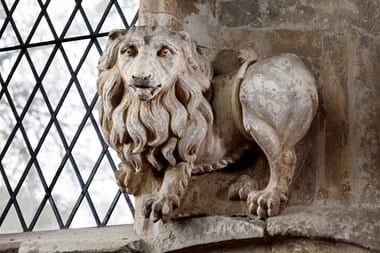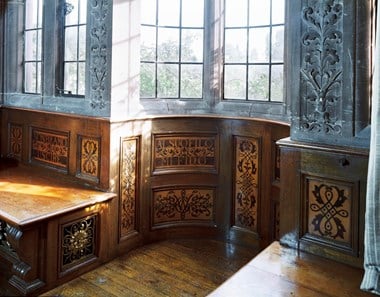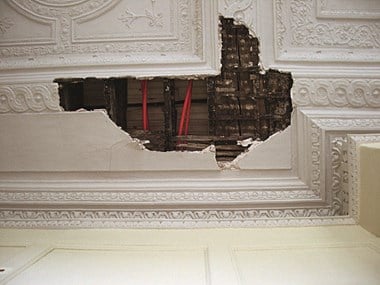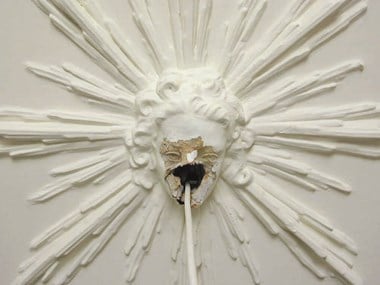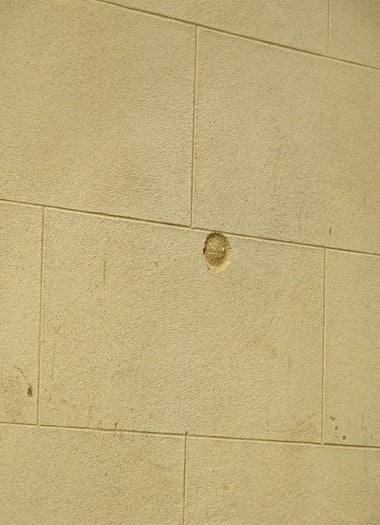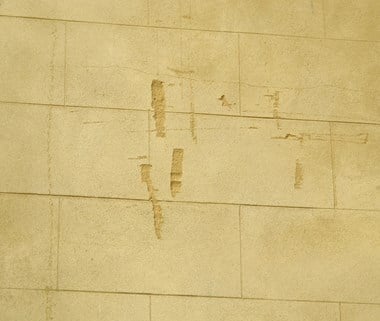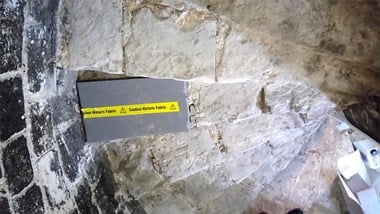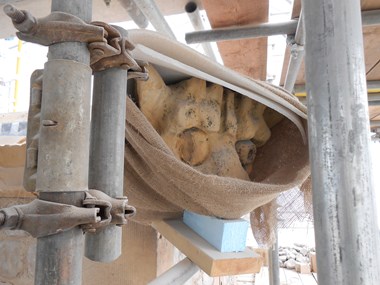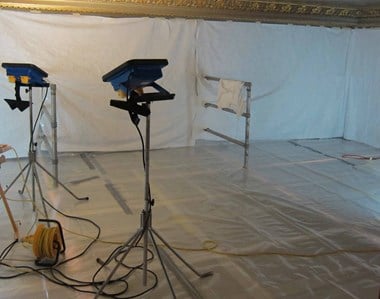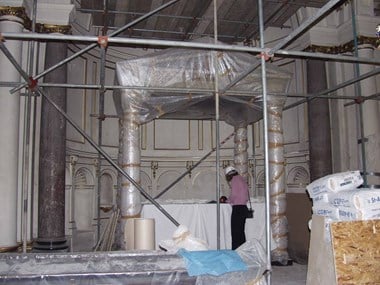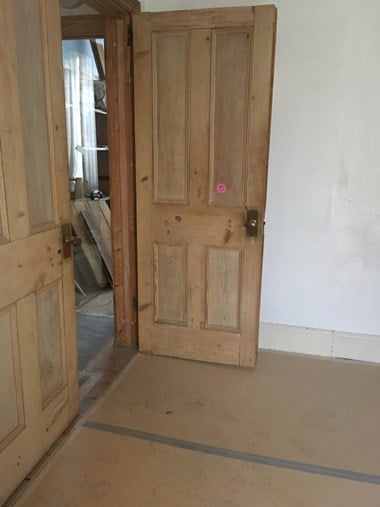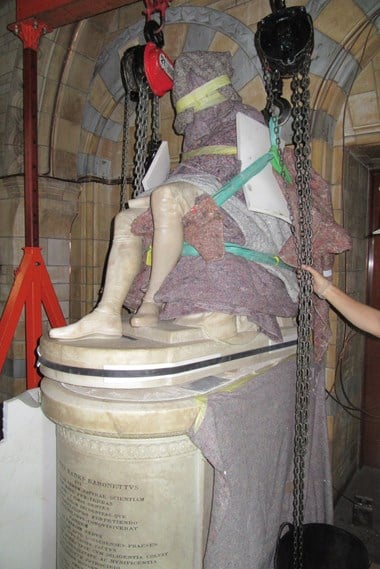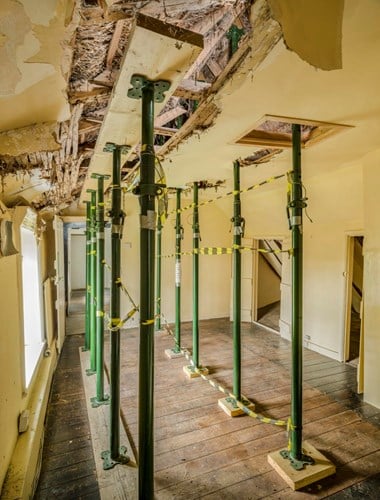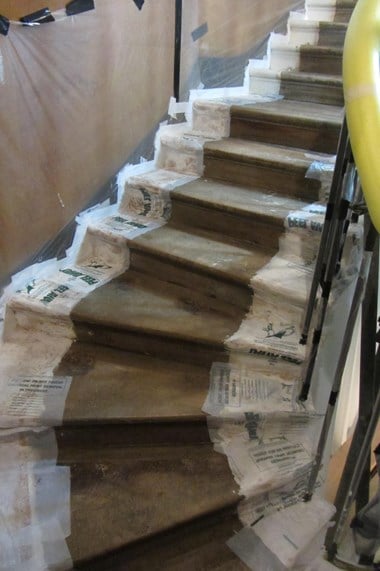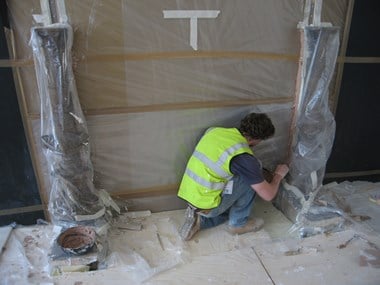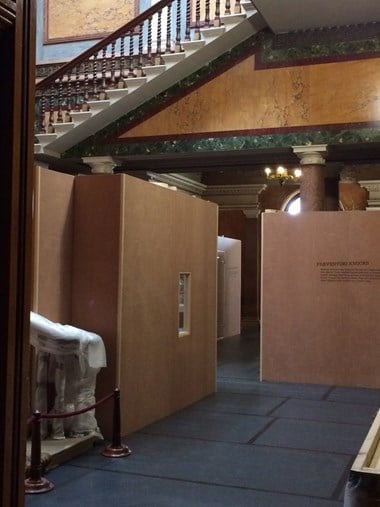Temporary Protection of Historic Features During Building Works
Mistakes or accidents during building works can cause irreparable damage to something of huge historic importance, artistic value or local significance. This page will help you minimise risks.
Our historic sites, monuments and traditional buildings give people a unique connection with the past. Maintenance, conservation and repair are essential to their preservation, as inevitable decay and deterioration affect the building fabric. During such works, one small mistake or accident may cause irreparable damage. This document will help you avoid or minimise risks during building works.
Features such as wall paintings, tiles, glazing, architectural decoration, statuary, stone monuments, metal railings, floors, fireplaces and fixed furnishings are integral to historic and traditional building fabric. They are, therefore, susceptible to accidental damage during building works, especially if they are fragile or already in a vulnerable condition.
Features requiring protection
Please click on the gallery images to enlarge.
Building works to renovate or alter a building can include:
- Alterations and repair to the fabric
- Redecoration
- Provision of services (such as electrical or plumbing installations)
- Asbestos removal
All of these potentially put historic features or other features of significance at risk. This guidance contains general information and advice on ensuring you protect historic features when planning works.
Before planning any building works, bear in mind that important earlier historic features may be hidden from view by later alterations. See the Historic England guidance on Understanding Historic Buildings and Wall Paintings: Anticipating and Responding to their Discovery for more information.
What type of hazards should I be concerned about?
Building works can pose risks to historic fabric and fittings, or may accelerate their deterioration. Where contractors are poorly briefed, the risk is much greater. Damage may be caused by:
- Mechanical impact or abrasion
- Water
- Vibration
- Chemicals
- Environmental factors
- Fire
- Inappropriate work
- Theft
These risks can be reduced by carefully planning the work programme. It may be useful for the architect or project designer to produce a document that identifies the features most at risk. This way, any protection requirements can be flagged up during the early stages of project design and built into the project’s budget. Costs associated with setting up the appropriate level of protection can be measured in a bill of quantities; this also ensures that the contractor is aware of any protection requirements.
Damage to historic features
Please click on the gallery images to enlarge.
Who do I contact for advice?
The level of advice needed depends on the significance of the architectural features. If the building is listed, then the list description may provide some information about features of significance. The Historic England Listing Selection guides provide further information regarding the types of features or elements of a building that contribute to its heritage significance.
For buildings that contain particularly important decorative fixtures and fittings, you should consult an architect or conservator for advice on how best to protect them. We have published guidance on finding accredited professionals working on the conservation of historic buildings. If you need a conservator, it is important to choose someone with the correct specialism and with relevant experience. You can read our guidance on commissioning a conservator.
For buildings with less important historic features (whether designated or not), specialist advice may not be required. It may be sufficient to flag up areas of concern to those working in the building, to make sure they take particular care to avoid causing any damage. For example, this may include taking care during access-egress, especially when carrying scaffolding poles or other equipment; identifying clearly the ‘care needed here’ areas; and avoiding hot works or power tools (or following strict safety protocols if these are unavoidable).
What protocols do I need to follow?
Whether an asset is listed or not, if historic features are present, it is best practice to carry out a heritage assessment or statement of significance in order to fully understand the potential importance of any fixtures, fittings and features.
If your building is listed or scheduled, you may need consent for temporary protective measures as well as for the building works themselves. Our guidance on heritage consents explains who you need to contact. You may need to provide a method statement for the protective works as part of the application or as a condition of its approval. If the need for temporary protection is identified after permission for building work is approved, contact the authority that granted the permission to discuss whether further consent is needed.
It is important to carry out a risk assessment before work begins. This should take into account the duration of the project, the protective measures proposed and the existing environmental conditions. All contractors should receive written details on the significance of the historic features and why they need protecting. This information should be included in the contractors’ risk assessment method statement.
All works, including temporary protective measures, will need to follow the relevant health and safety practices.
There may also be specific insurance requirements, especially if the building will be unoccupied during the works. Seek further advice from your building’s insurer or broker.
What type of protection do I need?
The appropriate method for protecting historic features will depend on the site and the specific nature of the project. For small projects, or those involving fabric or features of comparatively low significance, this may simply mean communicating with those working in the building, appropriate signage and a basic protective cover over any features deemed to be at risk. For larger projects, or those involving highly significant features, more robust protection will be needed.
Protection measures can be either indirect or direct – and it is likely that elements of both will be useful.
Indirect measures
- Awareness - Good communication is vital to make sure all parties are aware of all historic features that need protecting. Using displays or signs and ‘toolbox talks’ (short presentations to builders and all members of the team to flag things up) may help
- Project design - The best method for conserving and protecting the historic feature(s) during building works should be determined by a conservator. Creating a ‘watching brief’ may also be useful, to monitor the project at regular set intervals
- Controlling access - External exclusion zones for plant or lorries bringing in materials or scaffolding will prevent them driving into anything important. Rooms not affected by building works should be closed off. Physical barriers should be installed where access through a particular space is necessary
- Taking care with scaffolding - Putting up and taking down scaffolding should be supervised, preferably by a staff conservator or informed site manager (or building owner for smaller scale projects), to ensure that the owner or custodian has oversight. To avoid introducing additional dust and moisture to the site, specifications should stipulate that scaffolding poles and boards are clean and dry. We have published further advice on scaffolding and access platforms in our guidance on vacant buildings
- Containing the works - Covering scaffolding with sheeting, putting up enclosures to contain supplies, installing deflection boards and using extraction equipment or tools with integral dust bags will help to reduce the spread of harmful materials and dust to some extent. Water arising from plumbing and wet works, such as plastering, should be contained using waterproof screens and sheeting
- Recording the works - Before work starts, detailed photographs and other records of decorative features should be created. These will form a useful record to help with repair or reinstatement if any damage occurs
Indirect protective measures
Please click on the gallery images to enlarge.
Direct measures
These forms of protection can, in themselves, damage historic features. They should, therefore, be installed with care and, in the case of significant features, under the supervision of a qualified conservator.
- Emergency stabilisation - Localised remedial conservation treatment may be required if the conservator determines that the historic feature is not robust enough to withstand wrapping or boxing in, or the building work itself. Elements that have become entirely detached may be packaged, clearly labelled to identify their exact provenance location and removed temporarily from the site
- Temporary protection - Protective materials over and around the historic feature may need to be installed, to reduce the risk of impact, exposure to dust and debris, and liquid damage. Generally, this will involve wrapping or boxing in the feature. The following criteria should be considered when selecting a suitable protective material:
- Flexibility/rigidity
- Impact resistance
- Weight
- Ease of fixing
- Transparency
- Liquid water and water vapour permeability
- Fire-retardant properties
- Costs, availability and ease of disposal
- Sustainability and recyclability
During works that involve certain chemicals, protection from chemical attack would also be needed. Further information on methods of protecting features is included in our guidance on managing risks in vacant historic buildings.
Direct protection
Please click on the gallery images to enlarge.
What type of difficulties might I encounter?
If the protective covering is sealed to avoid dust, this will affect the microclimate immediately around the feature. For example, if the covering is impermeable and restricts air movement, there is a risk of moisture accumulating within the enclosed space if temperatures fluctuate. It is, therefore, important to evaluate the likelihood of creating an adverse microclimate around the feature.
It may be difficult to secure protective sheeting safely in place, especially when it is not possible to attach fixings to the historic fabric itself. In these instances, you may need to consider a freestanding or self-supporting covering or enclosure. For this type of protection, it is essential that the covering material is not allowed to come into direct contact with delicate surfaces. The system itself must be secure and must not create a further hazard. Adhesive tape should be avoided because it can discolour a surface or strip off the top layer when removed. However, in some circumstances (for example, for uncoated substrates with low porosity and sound condition), the conservation architect or conservator may deem that low-tack tape can be used for a limited period.
Where there is a risk of impact from heavy debris, such as falling plaster or masonry, or where an internal feature is temporarily exposed to external conditions, a more robust system of protection will be necessary. Examples include boxing in the feature using rigid materials (timber and plywood, for example), installing a crash deck or fitting a temporary roof. Incorporating access points, such as hinged panels, is useful for monitoring the condition of the protected feature during the project, and may be necessary if the enclosure is left in place for some time.
Installing any of these protective systems will pose risks, and work should be closely supervised by a conservation architect or a conservator.
Recycling protective materials
It is important to dispose of plastic or paper-based protective materials appropriately. Many companies provide recycling services for these materials and disposal options should be considered when choosing a protective method.
The Building Research Establishment (BRE) and The Waste and Resources Action Programme (WRAP) websites provide further information.
What can I expect a conservation architect or conservator to do?
Assess and plan
- Examine the site at an early stage to establish the survival, extent, significance and condition of historic surfaces and features
- Meet with the client, custodian, site architect or conservation professional responsible for coordinating the works to review the proposed building project
- Carry out a risk assessment of the historic feature(s) and agree recording and documentation requirements
- Determine emergency conservation requirements and their sequence
- Agree the appropriate protection measures for historic surfaces and features with the contractor(s)
- Devise a schedule of works, including identifying components that require specialist supervision or monitoring
Document and stabilise
- Undertake or commission any necessary recording of the condition of existing historic features
- Carry out or oversee any emergency conservation work in preparation for the building works
Protect and monitor
- Advise on appropriate methods of protection
- Carry out or supervise installation of all measures, and instruct site staff about the risks
- Depending on the duration or type of work, monitor the condition of the protective measures and/or of the historic feature itself. If necessary, adapt and increase protection during the project
- Supervise or undertake removal of the protective system
- Assess the condition of the historic feature during the works and after completion, before the final certificate is signed off
- Complete the final report and produce any conservation proposals and long-term recommendations


